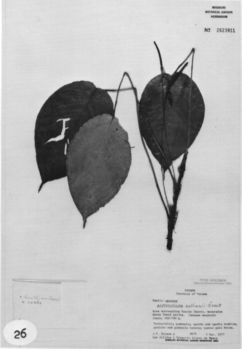




TYPE: Panama. Panama: Serrania de Canasas, vicinity Rancho Chorro above Torti Arriba, 400÷ 700 m, Folsom & Collins 6676 (MO, holotype; K, PMA, isotypes).
Terrestrial; stems elongate, 10 cm or more long; leaf scars obscured by persistent cataphylls, cata-phylls 2.5-3 cm long, drying medium brown, weathering into fine fibers.
LEAVES erect-spreading; petioles 18-21 cm long, 2-3 mm diam., terete; blades ovate, moderately thin; long-acuminate at apex, rounded to weakly subcordate at base, 13-15 cm long, 8-9 cm wide; both surfaces semiglossy, glandular-punctate; midrib raised above and below (dry); primary lateral veins 10-12 per side, departing midrib at 45-50° angle, prominulous above and below (dry); interprimary veins visible above, obscure below (dry); collective vein arising from near the base, 6-7 mm from margin, raised above and below, loop-connecting primary lateral veins, forming an acute angle with margin near apex.
INFLORESCENCE shorter than leaves; peduncle 14-16 cm long, 1-2 cm diam., shorter than petioles; spathe reddish, thin, lanceolate, ca. 2 cm long, 6-8 mm wide, acuminate at apex, acute at base; spadix reddish, 3-4 cm long, ca. 3 mm diam. at base, 2 mm diam. at apex, the sides sigmoid, 3-4 flowers visible in the principal spiral, 4÷5 flowers visible in the alternate spiral; tepals semiglossy, lateral tepals 0.4-0.6 mm wide, the inner margins convex; pistils emergent; stigmas exserted, brush-like; stamens exposed just above tepals; anthers persisting after anthesis, ca. 0.2 mm long, ca. 0.5 mm wide; thecae ovoid, slightly divaricate.
INFRUCTESCENCE with berries (immature) globose, purplish in upper half, greenish in lower half; mesocarp with numerous punctiform, whitish raphide cells; seeds (immature) 4, oblong, light brown, 2 mm long, 1 mm wide, conspicuously flattened, slightly tapered toward apex (point of attachment), rounded at base, enveloped in a flattened, transparent sack that is longer and broader than the seed itself. Fig. 26.
Anthurium collinsii is endemic to Panama in the Serrania de Canasas in southeastern Panama Province at 400 to 700 m. The species is known only from the type collection, probably collected in tropical wet forest but possibly in premontane rain forest.
Anthurium collinsii is a member of section Porphyrochitonium and is distinguished by its terrestrial, vine-like habit, its slender stems with old cataphyll fibers persisting at the nodes, its terete petioles longer than the blades, its ovate, abruptly long-acuminate, glandular-punctate blades with a single collective vein, and especially by its reddish spathe and spadix. It is most closely related to Anthurium subrotundum of the Serrama de Pirre near the Colombian border. That species differs in having blades essentially rounded at the apex and green to white spadices. Anthurium collinsii is also related to A. melastomatis, a species endemic to the province of Code near El Copé. The latter differs in having more narrowly ovate leaves with three collective veins.
The species is named in honor of Leo Collins, one of the collectors of the type specimen.

Panama: mountains above Torti Airiba, Fotsom et al. 6676 (K, MO, PMA).